Popular searches
Popular pages.
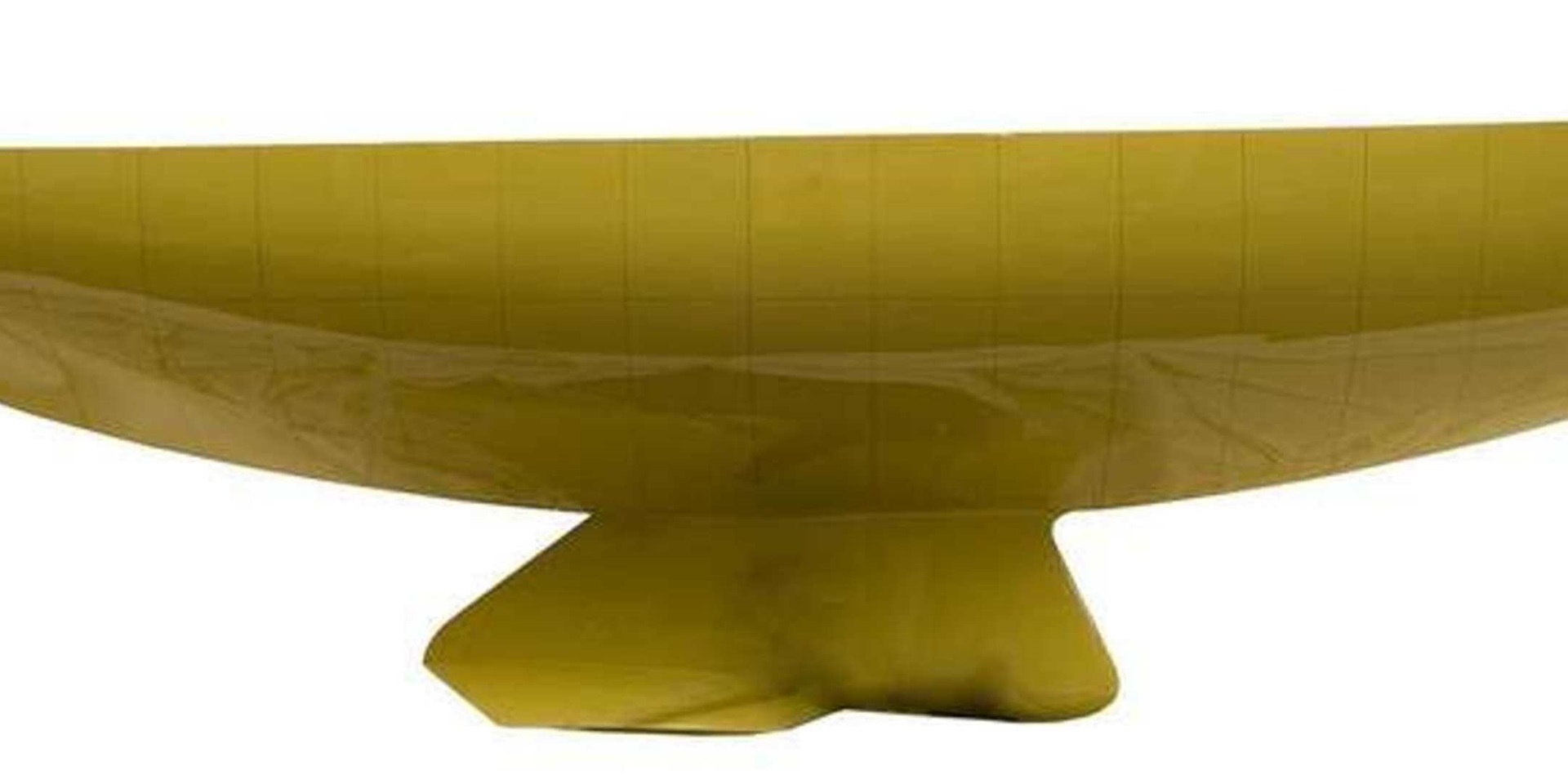

AUSTRALIA II, the winged keel and more
Australia II has become one of the nation’s most recognisable vessels, thanks to that extraordinary America’s Cup win in 1983. Almost everyone knows about its winged keel that seemed to make it unbeatable. The keel completely spooked the Americans who tried many moves off the water to avoid having to race against Australia II . However there was much more to the boat than just that keel, because its peculiar advantages allowed other subtle changes to be made that further helped Australia II to dominate many races. Designer Ben Lexcen had trialled endplates and other similar features on rudders, centreboards and keels at different times in his career, starting with a Moth class dinghy in the late 1950s, and then the break-through 18-foot skiff Taipan in 1959. The focus of his efforts was to reduce the drag and loss of efficiency from tip vortices off these appendages. These experiments met with mixed success but when he returned to the idea again in the 12 metre class, he developed the concept from a different direction.
Twelve metres are designed to detailed rule for their allowed dimensions. They are heavy boats for their length, with a considerable amount of ballast. The draft restrictions and large volume of the hull result in a shallow depth keel, with a poor aspect ratio and poor efficiency. The wings on the keel helped to reduce these inefficiencies in a similar way to the endplates he had experimented with, but he was able to make another bold step in lateral thinking. Rather than just realising the improvements to drag, Lexcen could see other advantages at the same time, and this was characteristic of his ability to think around many things at once.

These two half models in the ANMM collection show a comparison of a conventional 12 metre Australia (1977 and 1980) above with Australia II below.
The wings were made quite large which concentrated more of the lead ballast lower down, an improvement to stability and therefore the yacht’s speed. At the same time Lexcen was looking at an inverted or upside down keel profile, so that the longest chord and greatest mass was now at the base, not where it met the hull. This upside down profile and additional weight in the wings ensured that the ballast keel’s centre of gravity was now significantly lower than a conventional 12 metre design, as well as being a more efficient shape.
Lexcen then optimised the hull and rig proportions around the advantages this keel offered by choosing to design the hull with a slightly shorter waterline and greater sail area than normally used by other 12 metres. Careful manipulation of the hull shape at the measurement points ensured it had a long waterline when heeled to take advantage of the power that was achieved with more sail and more stability than the other designs.
There is a complex set of choices and compromises that have to be made in relation to the best proportions and shape of the keel and hull around the desired hull dimensions and sail plan area allowed by the rule. There are always penalties along with advantages. In this case one of the significant penalties was the greater wetted surface area and resultant drag, coming from the addition of the large wings. With the aid of the tank testing using one-third scale models and computer simulations it was possible to trial a variety of models generated from Lexcen’s basic concept, often making gradual changes as suggested by the testing. When the model with the best ratio of gains to losses was identified, the final design was then able to be drawn.

The final one-third scale tank test model of Australia II , part of the National Maritime Collection and on display in Wharf 7 foyer.
Australia II proved a breakthrough, and a handful as well (at least initially), but not because of any significant errors in the design. While one adjustment shortly after launching was to move the keel aft about 250mm for better balance, the major issue was simply that the proportions and shape gave Australia II characteristics that were new to 12 metres. It was stiffer and could hold on to its sail better in fresh conditions, and was much more manoeuvrable in pre-start situations.
As the crew began to sail the boat in Australia, working on producing the best sails, teamwork and racing skills, they realised there was something special about Australia II , but probably could not have imagined the drama ahead that would be the final race for the Cup on 26 September 1983.
Join us for a fascinating talk about the Australia II America’s Cup win this Thursday 26 September at the museum.
Share this:
- Click to share on Facebook (Opens in new window)
- Click to share on Twitter (Opens in new window)
- Click to print (Opens in new window)
- Click to email this to a friend (Opens in new window)
- Click to share on Pinterest (Opens in new window)
- Click to share on Tumblr (Opens in new window)
- Click to share on LinkedIn (Opens in new window)
- Click to share on Reddit (Opens in new window)

David Payne
David Payne is Curator of Historic Vessels at Australian National Maritime Museum, and through the Australian Register of Historic Vessels he works closely with heritage boat owners throughout Australia researching and advising on their craft and their social connections. David has also been a yacht designer and documented many of the museum’s vessels with extensive drawings. He has had a wide sailing experience, from Lasers and 12-foot skiffs through to long ocean passages. Since 2012 he has been able to work closely with Aboriginal communities on a number of Indigenous canoe building and watercraft projects.

- CLASSIFIEDS
- NEWSLETTERS
- SUBMIT NEWS

Australia II - John Rousmaniere reflects on that winged keel
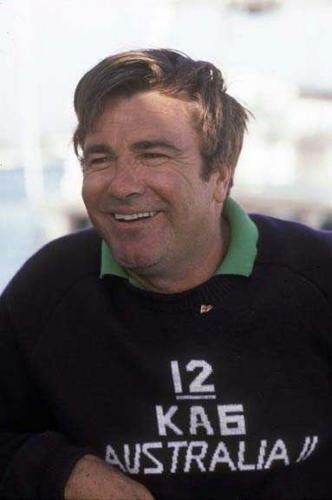
Related Articles
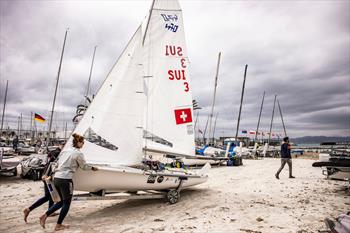
- International edition
- Australia edition
- Europe edition
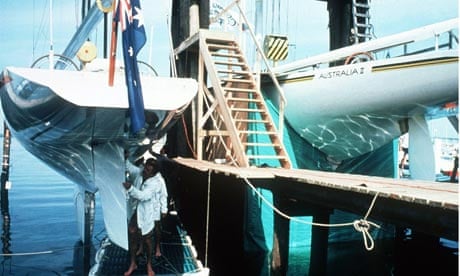
Australian 'did not invent winged keel on yacht that won America's Cup'
It was a sporting victory that inspired Australia's then prime minister, Bob Hawke, to declare any boss a "bum" if they sacked a worker who took the day off to revel in the nation's glory.
But now the legacy of the Australian yachting team's spectacular triumph, when it seized the America's Cup in 1983 to end the New York Yacht Club's 126-year grip, has been rocked by claims that the man hailed as a hero for the winning vessel's revolutionary design only played a minor role in its creation.
Ben Lexcen is credited for Australia II's winged keel. But Peter van Oossanen, a Dutch naval architect who worked with Lexcen on the vessel, says he can confirm what the Americans alleged in protracted court battles but could not prove – that the boat broke America's Cup rules on yachts having to be designed by residents or citizens of the country they represented.
Van Oossanen says that he and a Dutch aerodynamicist, Joop Slooff, designed the upside-down keel and its winglets and that Lexcen was not even in the Netherlands during crucial development phases and may contributed 5% or 10% to the design. "He had a flair for things, a flair for shapes. But he wasn't a scientist and he wasn't able to understand the full physics of what was going on," Van Oossanen said.
"He left to go back to Australia … before the vital tank tests. The role he played was a minor one." But he added that Lexcen, who was awarded the Order of Australia and had a car name after him, was a "true Australian hero" as well as a friend until his death in 1988. After years of silence, Van Oossanen, who became an Australian citizen 19 years ago, said he had become frustrated with the glorification of Lexcen and the denial of the Dutch role in Australia's victory. "I would have taken this to my grave. But they are writing us out of history.
This is the first time Van Oossanen has explicitly claimed Lexcen was not the designer."
He claims that the millionaire businessman Alan Bond, who bankrolled the Australia II yachting team, paid him A$25,000 to keep silent. Bond, who has since served four years in prison for illegally siphoning money from his company, countered that Van Oossanen's claims were malicious and the sum was payment for extra work done.
"This was Ben's idea completely. The idea is sacrosanct, and to suggest otherwise is mischievous and an insult to his memory," Bond said.
But others have also rallied to Lexcen's defence. Australia II's reserve skipper, James Hardy, said that while "there is no doubt that [Van Oossanen] did a lot of work", Lexcen was the creator, who had adopted aerodynamic elements on his revolutionary 18ft skiff in the late 1950s.
Australia II skipper, John Bertrand, said Lexcen was Australia's Leonardo da Vinci, but added that "success has many fathers".
- America's Cup
- Asia Pacific

Most viewed
clock This article was published more than 40 years ago
A Mystery Revealed: Australia's Bulbous, Blue Keel
NEWPORT, R.I., Sept. 26, 1983 -- They caressed it and climbed all over it. And it just didn't matter anymore.
Australia II's winged keel--the blue demon beneath the sea--deserved to be shown to its public after it carried the white-hulled boat to victory in the greatest show on water.
The keel, which had improved Australia II's maneuverability, performed one last bit of magic by guiding the 12-meter yacht through a maze of assorted welcoming craft tonight.
Three hours earlier, the boat had earned the hearty greeting by defeating U.S. defender Liberty in the seventh and final race of the America's Cup. The triumph ended United States' 132-year grip on sailing's top prize.
The jubilant Australian crew dispensed with its postrace routine of shrouding the innovative keel in plastic. And the gates of the Australian compound, usually stringently guarded, were opened wide to all comers.
Artists' renderings of the keel proved accurate. Instead of angling toward the stern of the boat, the front of the keel was a light blue bulb that pointed toward the bow.
The same color, which blends with the water and makes it difficult to see, also was used for the wings that jutted down from the bottom of the keel.
Thousands of spectators had lined the docks and dozens of boats had surrounded Australia II's slip for two hours before the boat arrived. Many chanted, "Let's see the keel."
They weren't disappointed.
Dennis Conner, Liberty's skipper and the first American helmsman in the Cup's history to guide a losing boat, also was present. He waved weakly to the crowd as he jumped off Black Swan, the tender of Australian syndicate chief Alan Bond.
Bond savored the victory, his first in four cup campaigns, and raised his arms to the cheering crowd. Victorious skipper John Bertrand accepted hugs and congratulations on the tender.
Although Australia II had been hoisted out of the water after each previous competition, for the first time its keel was left uncovered.
Ben Lexcen, designer of Australia II and developer of the keel, stood nearby. He had discovered the secret for ending the longest winning streak in sports and didn't care who knew it.
Several persons from the crowd climbed onto the six-foot wings while others pushed forward with such force that, finally, police locked the gates to the berth.
As Lexcen described it, when the yacht was hoisted from the water "about 500 Americans hung on it (the keel) like leeches."
Earlier today, the Toronto Globe and Mail reported it had obtained photographs of the keel, taken secretly underwater in July by a Canadian. The paper said the man, who asked that his name not be revealed, said he escaped with the pictures while a security guard struggled with Jim Johnston, a member of the Canada 1 syndicate.
Johnston was charged with trespassing, but the charge later was dropped.
"Jimmy and I decided to go for a swim and see if we could take a look at the boat," the second photographer told the newspaper. "It wasn't sanctioned by anybody."
ABC tonight reported that the Australians had submitted plans and pictures of the controversial keel to the British Patent Office in London and, for $3, anyone could have seen the file. On its network news, ABC aired two pictures of the keel from the patent office.

40th anniversary of Australia II yacht winning 1983's America's Cup: WA Maritime Museum
Ask anyone of a certain vintage the significance of September 26, 1983, and chances are their face will light up as they say, "that's when we won the America's Cup!".
The yacht Australia II made history when the oldest sporting trophy in the world was wrested from the Americans after 132 years.
Discussing the upcoming 40 th anniversary celebrations of the legendary win, crew member Skip Lissiman said the team had no inkling of the impact of the success until they arrived back in Perth.
"We had no idea how big it was back in Australia and how much people were getting behind it," he said.
"It was very unusual for people to support and follow a yacht race on the other side of the planet.
"So we were very surprised how big it was back here and I don't think in sporting terms there has been anything to equal it, although maybe the Matildas will."
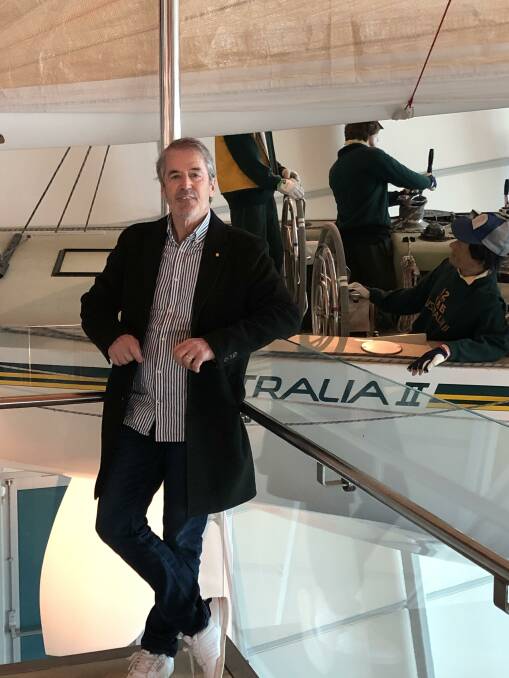
Former prime minister Bob Hawke recognised the win's impact on the nation's psyche.
"I sat next to him at the 30 th anniversary celebrations in Sydney and he turned to me and said, 'You know what, in all the things I did as a politician people still say the one thing they remember most about me is what I said on the day we won the America's Cup'," Skip said.
"His words were, 'Any boss that sacks a worker for not turning up today is a bum'.
"For all the reforms he achieved, that is the thing people remember."
Skip said his main feeling about the win at the time was relief.
"That was my second America's Cup. I did another one in 1980, and it took me nearly six months to get over the loss.
"So to win was a relief, but over time the elation kicked in."
That summer in Newport, Rhode Island, involved a lot of hard work.
"It was up early at 6am, an hour of exercise, throw some breakfast down, rush down to the boat, put the sails onboard, head out on the water - quite often it was a one-hour tow to get out to the race course area - get the sails up, test, check the winds, check the conditions, check the set-up, do some adjustments to the boat, then race."
He said the race could take as long as five hours.
"And it wasn't unusual for us to have two races in a day, then they would be more like to two-three hours each. Then tow back, get sails out of the boat, do any maintenance work, throw some dinner down, go to bed and repeat the same thing seven days a week."
Skip said many elements went into Australia II's success.
"Everyone focuses on the famed winged keel as being the magic thing that won the America's Cup. The reality was there was a multitude of components that went into the success.
"The winged keel was part of it, but equally the crew and the team were extremely well prepared and certainly on par or superior to the American team and crew."|
He said the sails were revolutionary in design, materials and how they were prepared, while the management skills in being one step ahead of the Americans were essential.
"The vision and backing of Alan Bond was exceptional," Skip said. "After being defeated three previous times he continued to persevere."
Skip is still very involved in sailing, having been on the board of directors of Australian Sailing for seven years. "If you are passionate about something and you can turn your passion into reality and commercialise it, then you are away."
An exhibition to mark 40 years since Australia II won the America's Cup will take place at the yacht's permanent home, the WA Maritime Museum , Victoria Quay, from September 9-February 4.
Australia II: 40 Years On will include a new film featuring untold stories by the 1983 winning team members, including Skip. On the second Tuesday of the month, entry to the maritime museum is by gold coin donation.
Advertisement
Get the latest Senior news in your inbox
Sign up for our newsletter to stay up to date.
We care about the protection of your data. Read our Privacy Policy .

- Skip to Navigation
- Skip to Content
Celebrating 30 years of Australia II – see the famous America’s Cup-winning yacht
News | Created 25 Sep 2013

Relive the day the Royal Perth Yacht Club sailed to victory in the America's Cup with gold coin entry to the country’s most complete Australia II collection this Thursday 26 September to Saturday 28 September at the Western Australian Maritime Museum in Fremantle.
The purpose-built Maritime Museum has housed the iconic winged keel yacht since 2002, and is now also home to one of the most significant America’s Cup collections in the world, including one of only three exact replicas of the coveted Cup, thanks to a donation by Kerry Tasker, widow of Australia's first Olympic sailing medal winner, Rolly Tasker, and the Australian Sailing Museum.
WA Museum history curator Sally May said it was fantastic to have the two collections together for the 30 th anniversary of the historic victory.
“The cup itself represents a momentous occasion in not only Australian, but international maritime history, and it’s fantastic to now have it alongside the yacht responsible,” Ms May said.
The donated collection also includes plans, records and images of America's Cup challengers and defenders from 1851 to 2003; some 100 models of Australian competitive racing classes; and mannequins of significant America's Cup identities from 1851 to 1983.
Skippered by John Bertrand, Australia II’s 1983 victory was the first time in 132 years the America's Cup had been won by a nation other than the United States. The defending New York Yacht Club had held the cup since 1851, the longest winning streak in international sporting history. It was the race that stopped the nation: televised in Australia in the early hours of the morning and celebrated in homes, pubs and clubs across the country. Then-Prime Minister Bob Hawke was at the RPYC in Crawley when he famously declared: "Any boss who sacks anyone for not turning up today is a bum!”
On Saturday, included in the gold-coin donation entry to the Museum, visitors can watch as more sporting history is made when the Fremantle Dockers take on Hawthorn in the AFL Grand Final , televised in the Museum’s theatre from noon.
The America's Cup replica, on display at the WA Maritime Museum Image copyright WA Museum
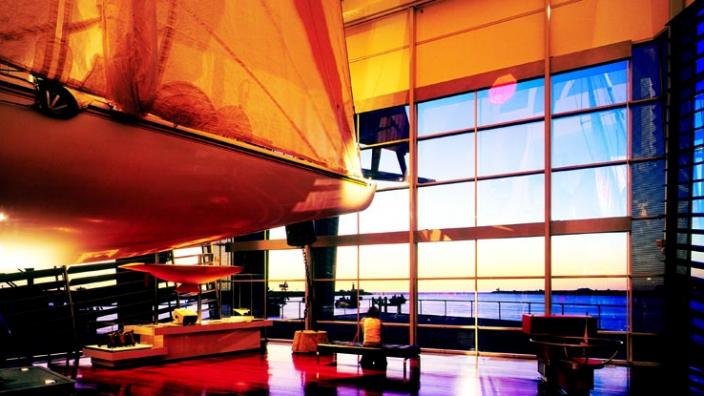
The Australia II Gallery, WA Maritime Museum, Fremantle Image copyright WA Museum
Media contact: Niki Comparti Western Australian Museum 6552 7805, [email protected]
Yacht Mark Twain being refurbished in bid to compete in Sydney to Hobart race once more
For the better part of five decades, one yacht returned to the starting line of the Sydney to Hobart race more than any other.
The timber and fibreglass hulled Mark Twain was built in 1971 and has competed in the race a record-breaking 26 times.
But since its last effort in 2018, it has languished at port.
The yacht's new owner, Rob Payne, who refers to himself as the boat's custodian, has grand plans to refurbish the vessel, a Sparkman and Stephens 39, and return the Mark Twain to its former glory.
Although he hopes to return the boat to the starting line of the Sydney to Hobart, he also believes the yacht can be used for a greater good.
Along with Beaconsfield mine disaster survivor Brant Webb , Mr Payne has plans to establish a group called Old Saltys, which will aim to use sailing as a vessel to empower youth through sharing knowledge.
"Sailing is a metaphor for life. You've got to trim your sails and set your course and you're gonna get buffeted around," he said.
The Old Salty's motto will be 'well-weathered wisdom', and the men believe they have a lot of life experience they can share with young people anywhere Mark Twain can sail.
Mine collapse survivor finds solace on the sea
Brant Webb, who was one of two miners rescued after spending 14 days trapped almost a kilometre underground when a Tasmanian mine collapsed in 2006, says sailing helped him after the ordeal.
"After Beaconsfield, if I was having a bad day I'd call up the GP and he'd say 'get the boat ready, we're going sailing'.
"I've been sailing since I was eight years old. All my life. That's the great thing about it, you can turn your phone off out there and no-one can find you."
Mr Webb said the Old Saltys group was intended for "sailors who are too old to race and too young to cruise".
"It gives us old folk a new lease on life. The whole thing is to connect people, to put the unity in community, which we lost during COVID."
Mr Payne, a recent transplant from New Zealand, said he was heartbroken by the condition of the Mark Twain when he first found it in 2020.
"When I saw it, it broke my heart," he said, adding that he had the opportunity to "do something about" refurbishing the "old girl".
"We're only ever the custodians of these extraordinary vessels."
Once a fine racing yacht, the Mark Twain had fallen into disrepair in port at George Town in recent years.
From its first entry in the Sydney to Hobart in 1971, the boat long held the steadily increasing record for the greatest number of entries in the iconic race, even managing to clinch podium finishes for its class on several occasions.
Throughout the latter half of the 20th century, it competed in more than 20 Sydney to Hobart races, and in 2002 became the first-ever boat to have sailed in 25.
"Thousands of men and women have sailed on this beautiful vessel," Mr Payne said.
It was bought and refurbished for its 26th entry by veteran Sydney to Hobart skipper Michael Spies in 2018, but that was the last time it took part.
Mr Payne spent several months last year refurbishing the boat's hull himself and on Wednesday, March 27, the mast and boom were removed to be restored by a Beauty Point shipwright.
Along with Mr Webb, he hopes to take the Mark Twain around Tasmania, Australia and New Zealand and share their knowledge of the seas.
"My encouragement to youth is to get into sailing and you know, become part of the community within those sailing clubs," Mr Payne said.
"You don't necessarily have to own a huge boat … you can be in a little sabot [dinghy] and have that experience on the water. It's life changing and transformational."
He is keen to share the refurbishment project with anyone who wants to be involved and hopes the Mark Twain will sail again in the next two to three years.
- X (formerly Twitter)
- Beaconsfield
- Mental Health

IMAGES
VIDEO
COMMENTS
Australia II has become one of the nation's most recognisable vessels, thanks to that extraordinary America's Cup win in 1983. Almost everyone knows about its winged keel that seemed to make it unbeatable. The keel completely spooked the Americans who tried many moves off the water to avoid having to race against Australia II.However there was much more to the boat than just that keel ...
Design. Australia II was designed by Ben Lexcen, built by Steve Ward, owned by Alan Bond and skippered by John Bertrand. Lexcen's Australia II design featured a reduced waterline length and a short chord winged keel which gave the boat a significant advantage in manoeuvrability and heeling moment (lower ballast centre of gravity) but it was a significant disadvantage in choppy seas.
Winged keel of Australia II. The winged keel is a sailboat keel layout first fitted on the 12-metre class yacht Australia II, 1983 America's Cup winner. Design ... Note that, contrary to classic configurations, the keel of this boat is "upside down" under the hull (the root chord is smaller than the tip ...
Australia II's 1983 America's Cup win was largely credited to her revolutionary winged keel design. By Gary Reich. March 27, 2014. All sorts of interesting things happened back in 1983. McDonald's introduced the Chicken McNugget, Microsoft Word was released, and Swatch watches were all the rage.
At that time, the rules governing the Cup required that each yacht be designed by citizens of the country it represented. The principal designer of Australia II, the eventual winner, was indeed a "national"-Ben Lexcen. Much of the development work on that boat, however, was performed at the Netherlands Ship Model Basin (now known by the acronym ...
Winged Victory - the untold story of Australia II's keel design. by www.proboat.com on 30 Sep 2009. The man whose name is synonymous with the winged keel, Ben Lexcen was the most prolific Cup designer over the five-match period that ran from 1974 through 1987. Rolex. In the summer of 1983, in the months leading up to the 25th America's Cup ...
11:45 AM Thu 15 Oct 2009 GMT. 'The man whose name is synonymous with the winged keel, Ben Lexcen was the most prolific Cup designer over the five-match period that ran from 1974 through 1987.'. Rolex. Noted America's Cup historian, John Rousmaniere reflects on the current brouhaha over the designer of Australia II's winged keel.
A lot. In hindsight, the 1983 America's Cup looks like the marker buoy that the whole nation's idea of itself rounded, to head in a bold new direction, swapping out the old sails for a glorious new set of go-get-'em spinnakers. The cup seemed to sweep aside the cringing colonial relation to Mother England.
Significance AUSTRALIA II is a 12 metre class yacht built in WA in 1982. It was the yacht that won the 1983 America's Cup challenge against the USA and ended the longest winning streak in sporting history. It is a celebrated and radical design from Ben Lexcen featuring his winged-keel concept and was built by Steve Ward near Fremantle.
On 26 September 1983, the yacht Australia II made history when the oldest sporting trophy in the world, the America's Cup, ... The designer of Australia II, Ben Lexcen, had conceived a winged keel that under secret testing in the Netherlands had out-performed conventional keels. The yacht was built in Cottesloe by local boatbuilder Steve Ward.
Ben Lexcen. Updated on 1 March 2014. Benjamin Lexcen AM (born Robert Clyde Miller, 19 March 1936 - 1 May 1988) was an Australian yachtsman and marine architect. He is famous for the winged keel design applied to Australia II which, in 1983, became the first non-American yacht to win the prestigious America's Cup in 132 years.
Australia II Wing Keel Controversy Part 2. On the morning of August 6, 1981, Peter van Oossanen, left, and two technicians at the Netherlands Ship Model Basin (NSMB) carried out tests of the final hull, keel, winglets, trim tab, and rudder configuration of Australia II, the Australian challenger for the 1983 America's Cup. We pick up Peter ...
So revolutionary was the winged keel design that its legality was questioned by the New York Yacht Club upon its arrival at the selection trials for the cup in 1983. With the ruling in favour of the Australia II, the yacht participated in and won the Louis Vuitton Cup, dominating the competition.
Underneath, as half the world must know by now, lies the dreaded winged keel, a bulbous, delta-shaped device that has shaken this ancient boat race tradition to its very foundation and now threats ...
Some of his Australian 18s, model boats, and other designs had wing-like endplates and unusually small fins.When he worked on the design for Bond's 1977 Cup challenger, Australia, he and his associate, Johan Valentijn, tested wings and a keel 15 to 20 percent smaller than the norm before doubts about the accuracy of the tank tests led them ...
The winged keel made Lexcen's new boat, Australia II, much faster and more manoeuvrable - and importantly, the Australians' secret weapon also became a psychological weapon.
Toni O'Loughlin in Sydney. Wed 14 Oct 2009 12.13 EDT. It was a sporting victory that inspired Australia's then prime minister, Bob Hawke, to declare any boss a "bum" if they sacked a worker who ...
By Professional BoatBuilder, Mar 20, 2024. Revelers wanted to touch the wing keel of Australia II following the 12-Meter yacht's victory over the U.S. America's Cup defender, Liberty, in 1983. The controversial appendage was credited with making the performance difference that ended the trophy's 132-year possession by the United States.
Australia II's winged keel--the blue demon beneath the sea--deserved to be shown to its public after it carried the white-hulled boat to victory in the greatest show on water. The keel, which had ...
The yacht Australia II made history when the oldest sporting trophy in the world was wrested from the Americans after 132 years. Discussing the upcoming 40 th anniversary celebrations of the legendary win, ... "Everyone focuses on the famed winged keel as being the magic thing that won the America's Cup. The reality was there was a multitude of ...
Greater lift to windward would be generated by the winged keel as it heeled since the Depth to width ratio would improve. Australia II would be faster to windward and suffer from less leeway. 5 ...
The purpose-built Maritime Museum has housed the iconic winged keel yacht since 2002, and is now also home to one of the most significant America's Cup collections in the world, including one of only three exact replicas of the coveted Cup, thanks to a donation by Kerry Tasker, widow of Australia's first Olympic sailing medal winner, Rolly ...
In short: Rob Payne plans to refurbish the Mark Twain so it can race in its 27th Sydney to Hobart yacht race. The "labour of love" will become a vessel to host new sailors and help them develop ...